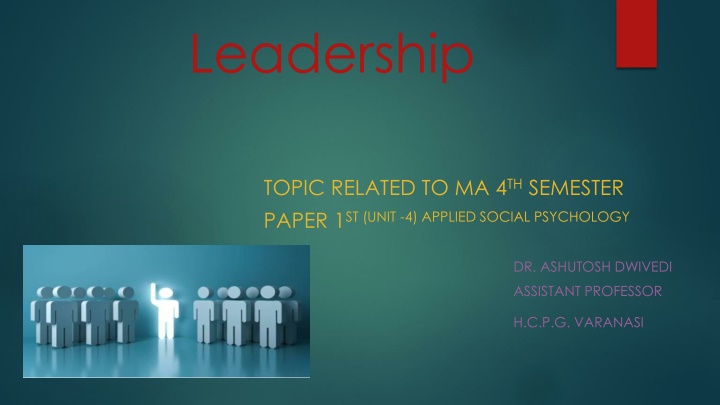
Characteristics of Successful Leadership in Applied Social Psychology
Explore the concept of leadership in applied social psychology as a process of influencing organized groups towards goal achievement. Learn about the interpersonal influence, communication process, and continuous nature of effective leadership. Discover the characteristics and styles of successful leaders based on research findings, emphasizing the importance of adapting leadership styles to different situations.
Download Presentation

Please find below an Image/Link to download the presentation.
The content on the website is provided AS IS for your information and personal use only. It may not be sold, licensed, or shared on other websites without obtaining consent from the author. If you encounter any issues during the download, it is possible that the publisher has removed the file from their server.
You are allowed to download the files provided on this website for personal or commercial use, subject to the condition that they are used lawfully. All files are the property of their respective owners.
The content on the website is provided AS IS for your information and personal use only. It may not be sold, licensed, or shared on other websites without obtaining consent from the author.
E N D
Presentation Transcript
Leadership TOPIC RELATED TO MA 4THSEMESTER PAPER 1ST (UNIT -4) APPLIED SOCIAL PSYCHOLOGY DR. ASHUTOSH DWIVEDI ASSISTANT PROFESSOR H.C.P.G. VARANASI
Leadership Leadership is an attempt at influencing the activities of followers through the communication process and toward the attainment of some goal or goals. Leadership is defined as the process of influencing the activities of an organised group toward goal achievement. ( Rauch & Behling)
Leadership is interpersonal influence, exercised in a situation, and directed, through the communication process, toward the attainment of a specified goal Or goals. ( Tannenbaum, Weschler & Massarik)
This leadership is a process in which a leader attempts to influence his/her followers to establish and accomplish a goal or goals. In order to accomplish the goal, the leader exercises his/her power to influence people. Leadership is also a continuous process, with the accomplishment of one goal becoming the beginning of a new goal.
Characteristics of successful leadership: A leadership study group at Ohio State University, headed by Harris Fleischman, found similar contrasts in leadership style, which they referred to as initiating structure and consideration. The leadership style of initiating structure is similar to the job centered leadership style.
It was the initial expectation of both research groups that a leader who could demonstrate both high initiating structure ( job structure) and high consideration ( employee centered) would be successful and effective in all circumstances.
Many students of leadership today believe that there is one best way to lead, believing instead taht appropriate leadership styles very depending on situations. Fred Fiedire(1967), for instance, believes that a task-oriented leadership style is appropriate when the situation is either extremely favourable or extremely unfavorable to the leader.
Style of leadership Autocratic Leadership Style: this style is a strong one dimensional leadership style that gives full power or authority to the leader/manager. In this style, the leader makes all the decisions without any consultation with team member.
Democratic leadership: This style is more participative in nature where the leader involves team member while making critical decisions. Coaching leadership: However, it is one of the most effective leadership styles taht does not lead directly but indirectly. In this style leaders are more like coaches or teachers which involves coaching or supervising team members.
Strategic leadership: It refers to the leader s potential or capability to express a strategic vision for the organisation and to persuade them to pursue that vision with the help of right strategies and tools. Transformational style: It is all about creating a thriving work culture through effective communication in team.
However, it demands a certain level of strategic vision and intellectual stimulation to initiate change in oneself and others in an organisation. laissez-faire Faire leadership: Laissez-Faire means in French is Let them do . In such a leadership style leaders delegate the responsibility to team member and let them work on their own with minimum or no interference. Mahatma Gandhi was Laissez-faire leader.
Theory of Leadership: Trait theory: Thomas Carlyle (1841) can be considered one of the pioneers of this theory. Although trait theory has an intuitive appeal difficulties may arise in Proving it s tenets and opponent frequently challenge this approach. This strongest Versions of trait theory see these leadership characteristics as innate and accordingly labels. Some people as born Leaders due to their psychological makeup.
Behavioural and style Theory: It is consider taht leadership as a set of behaviour evaluating the behaviour of stressful leaders, determining a behaviour taxonomy and identifying broad leadership styles.
The Managerial Model Theory: this theory is also based on a behaviour theory. The model was developed by Robert Blake and Jane Moutan in 1964 and suggests five different leadership styles, based on the leader s concern for people and their concern for goal achievement.
Situational And Contingency Theory: According to the theory what an individual actually does when acting as a leader is in large part dependent upon characteristics of the situation in which he functions .
Functional Theory: functional theory ( Hackman & Walton,1986; McGrath, 1926) is a particularly useful theory for addressing specific leader beahviours expected to contribute to organisational or unit effectiveness.






















